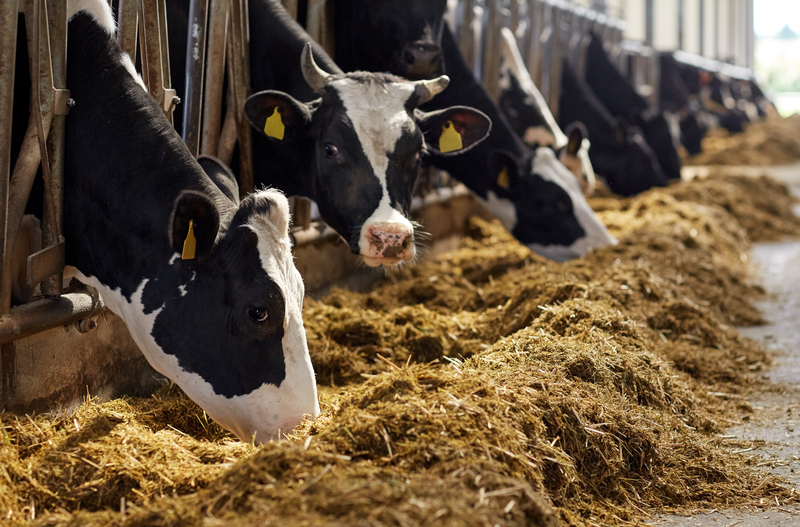Avoid Common Udder Injuries

Avoid Common Udder Injuries
Overall udder health is crucial for mature cows and upcoming replacements alike. Being able to identify the critical and subtle symptoms of injury, infection and other issues at all stages of udder development, lactation and rest allow for swift treatment, potentially saving many future lactations.
As always, prevention of serious udder issues is the most effective and the best approach to udder management and health. However, casualties are bound to happen in one way or another.
The healthy udder and its enemies
Overall udder health largely comes down to good hygiene practices before, during and after lactation periods. However, structural and genetic elements come into play as well. That is, the udders that are most likely to remain robust and avoid injury and pathogenic invasion have proper structure.
Cows and first calf heifers with weak ligaments and attachments, abnormal teat structure and similar characteristics should automatically be on your “watch list” for potential problems. The same can be said for animals that have chronically high somatic cell counts.
Common causes of wounds to the udder include fence wire cuts, hoof treads, abrasions from the pen or milking machines, animals pastured on abrasive terrain, insect bites, and suckling by herdmates. Insect bites usually include bloodsucking flies, mosquitoes, and midges, and may be exacerbated by licking of the area or expanded by abrasion by other insects, according to the Merck Veterinary Manual article Traumatic and Structural Disorders of the Bovine Udder by J. Eric Hillerton.
Teats generally have good blood flow, so superficial wounds heal well even with skin loss. Blunt trauma can do internal damage that causes later issues (University of Minnesota Libraries).
“Wounds into the teat lumen significantly increase the risk of mastitis from environmental contaminants prior to repair so waiting to fix the laceration isn’t a better option. Lactating animals will also be losing milk as long as the wound remains open. This can be a significant financial loss. If it occurs, fistula formation also continues to increase the risk of bacterial contamination and mastitis” (University of Minnesota Libraries).
What to look for
Serious udder injuries are not exclusive to the immediate mammary tissue. Injuries of concern include those to surrounding and supporting structures too. For example, cuts or lacerations that involve the primary milk vein ought to be immediately considered an emergency. Hillerton notes, “…because of the potential for severe hemorrhage; prompt compression and ligation of these lacerations is recommended. Deeper wounds of the udder and teats should be promptly (within 6 hours) cleansed and sutured or stapled under local anesthesia with appropriate sedation and restraint.”
“When the wound involves the teat cistern, it may be necessary to insert a self-retaining teat cannula with removable cap into the teat for the first 24 hours to prevent milk seeping through the wound (which would delay or prevent healing) and to aid in milking. The affected quarter should be infused with an antimicrobial preparation.”
In some older cows, the suspensory ligaments of the udder (most commonly the medial suspensory ligament) can gradually weaken or fail. This is often associated with factors such as over-engorgement and udder edema. As the ligament deteriorates, the udder begins to hang lower, and the teats may spread further apart, making it more difficult to properly attach the milking unit. In some cases, a sudden rupture of the ligament may occur around the time of calving, significantly increasing the animal’s risk of developing mastitis.
Edemas
Another consideration is udder edema, or a buildup of primarily lymphatic fluid. Sometimes heavy pregnancy will naturally cause a notable edema due to the weight of the calf putting pressure on the pelvic region that inhibits the routine flow of blood and various lymphatic fluids.
Cows with edema or a swollen udder can make it hard to attach the milking unit and milk flow may be disrupted. Animals with udder edema have an increased risk for development of mastitis.
“First-calf heifers are more susceptible to developing udder edema because even though the mammary system is already in place, significant development occurs during the last stage of gestation,” writes Carly Becker, a former Penn State educator in her article Udder Edema: Prevention Versus Treatment. “The increased demand of blood for the continued development of the mammary system is a precursor to udder edema.”
Udder edema remains a consistent challenge for producers, but its impact can be minimized by targeting several key management areas. These include providing a specialized diet for late-gestation heifers to control anionic salt intake, incorporating antioxidants like vitamin E, vitamin C, carotenoids, and flavonoids into the ration, and selecting bulls with proven traits that improved udder cleft, depth, and balance. Maintaining appropriate body condition during the dry period is also essential, as is targeting an age at first calving between 22 and 24 months.
Preventing edema can aid in avoiding milk production loss, damage to the udder ligaments, and increase longevity of the cow.
Teats
Teat end damage is a key concern when evaluating udder health. Damage to the teat end can restrict milk flow and create an entry point for bacteria, significantly increasing the risk of mastitis. This type of damage often results from improperly fitted milking units or overmilking. Physical trauma, such as a cow being stepped on while lying in a freestall, can also cause injury to the teat or udder.
In addition to teat end issues, udder bruising, lacerations, and abscesses should be closely monitored. These injuries can occur from poorly designed stanchions, overcrowded or tight milking stalls, or rough handling. Repeated rubbing or pressure on the udder may lead to sensitivity, swelling, or open wounds, all of which can compromise udder health and milk quality. Abscesses may form when bacteria enter through broken skin, requiring prompt attention to prevent further infection or systemic illness.
Proper housing design, gentle handling, and routine udder inspections are critical in reducing the occurrence of these injuries and maintaining optimal udder function. Trait selection is another tool of note that can go a long way in reducing teat issues in your herd. If you are unhappy with teat length and placement or find you are having issues, be sure to discuss with your breeding team and select for sires with these traits.
Practicing prevention
Prevention is always best—and in many cases, injuries can be avoided with careful management. While some incidents are inevitable, reducing the risk helps protect profitability by supporting healthy cows, maintaining milk quality, and ensuring more animals continue contributing to the bulk tank.
One of the most effective strategies for injury prevention is prioritizing cow comfort. Comfortable cows are less likely to suffer from slips, falls, or pressure induced injuries that can lead to bruising or udder trauma. This includes providing adequate bedding, proper floor grooving, ensuring freestalls and milking areas are properly sized, minimizing overcrowding, and maintaining a calm environment. Facilities that are designed well, along with consistent handling practices and regular health checks, form the foundation of good udder care and overall herd health.
Article by Jaclyn Krymowski
American Dairymen Magazine https://americandairymen.com/



